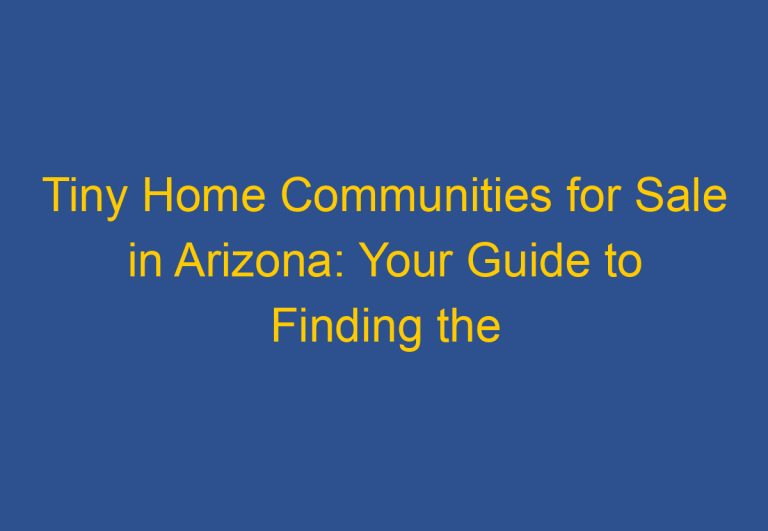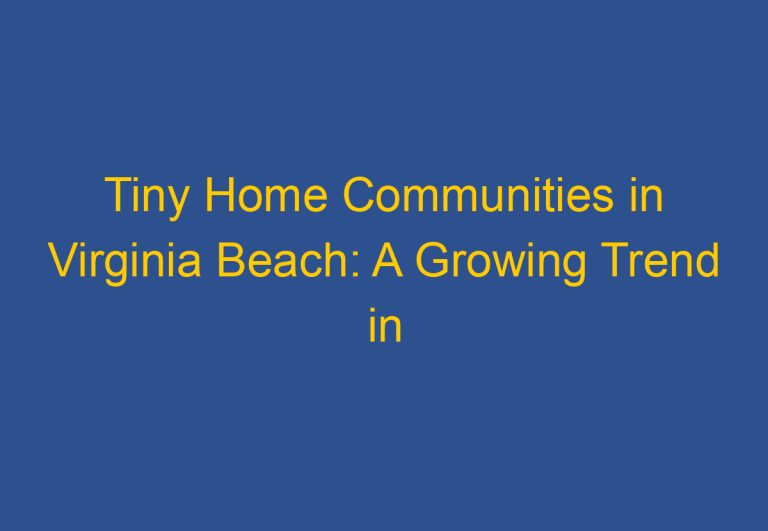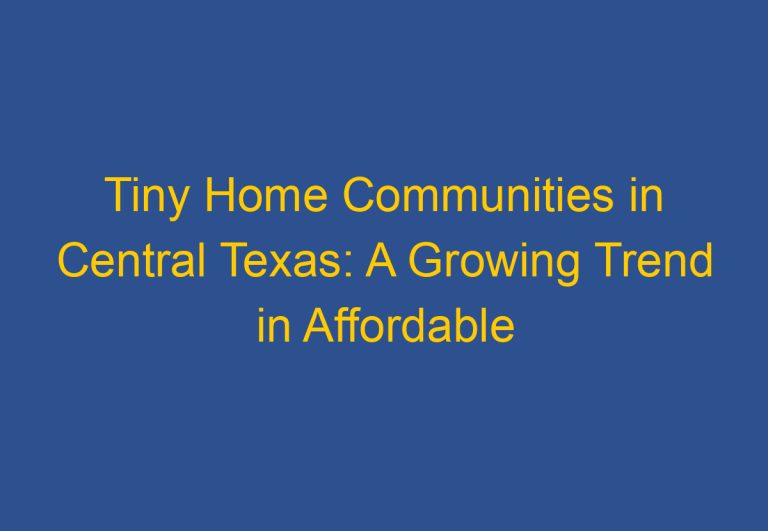Tiny Home Communities in Alberta: A Guide to Finding Your Perfect Community
Tiny home communities in Alberta are becoming increasingly popular among families looking for sustainable living options. The tiny house movement has gained momentum in recent years, and Alberta is no exception. With lower utility bills, minimal maintenance costs, and the ability to move homes to any location, tiny homes are an attractive option for those looking to downsize and simplify their lives.
One of the most significant benefits of living in a tiny home community is the sense of community and shared values. Residents of tiny home communities are often like-minded individuals who prioritize sustainability, minimalism, and a sense of community. Living in a tiny home community can provide a sense of belonging and support that is often lacking in larger, more traditional neighborhoods.
While tiny homes are undoubtedly not for everyone, they offer a unique and appealing lifestyle for those who value sustainability, community, and minimalism. With several tiny home communities in Alberta, families looking for a change of pace may want to consider this option for their next move.
Benefits of Tiny Home Living in Alberta
Tiny homes have become increasingly popular in Alberta in recent years due to their numerous benefits. The following subsections will discuss some of the advantages of tiny home living in Alberta.
Sustainability and Off-Grid Capabilities
One of the main benefits of tiny home living in Alberta is its sustainability and off-grid capabilities. Tiny homes are designed to be energy-efficient and use fewer resources, making them an environmentally-friendly option. Moreover, tiny homes can be equipped with solar systems, which means that they can generate their own electricity and reduce reliance on the power grid. This is particularly useful in Alberta, where there is an abundance of sunlight.
Affordability and Economic Advantages
Another advantage of tiny home living in Alberta is its affordability and economic advantages. Tiny homes are significantly cheaper than traditional homes, which means that they are an excellent option for those on a budget. Moreover, tiny homes have lower utility bills, which can save homeowners a significant amount of money in the long run. This is particularly important in Alberta, where the cost of living can be high.
In addition to the economic advantages, tiny homes also align with the values of many Albertans. Many people in Alberta value simplicity, minimalism, and sustainability, which are all characteristics of tiny homes. By living in a tiny home, individuals can reduce their environmental footprint and live a simpler, more intentional life.
In conclusion, tiny home living in Alberta offers numerous benefits, including sustainability, off-grid capabilities, affordability, and alignment with Albertan values. These advantages make tiny homes an excellent option for those looking for an alternative to traditional homes.
Legal and Zoning Considerations
When it comes to tiny home communities in Alberta, there are several legal and zoning considerations to keep in mind. These considerations are important to ensure that the tiny home community is safe, legal, and meets all the necessary requirements.
Alberta Building Code and Safety Standards
Tiny homes must comply with the same Alberta Building Code and safety standards as other permanent residential dwellings. This means that tiny homes will have to meet the same basic safety standards as family homes. The Alberta Building Code sets out requirements for everything from insulation and ventilation to plumbing and electrical systems.
Zoning Laws and Bylaws in Alberta Cities
Tiny homes must also comply with all land use regulations in accordance with the city’s land use designation. This means that tiny homes must comply with the same Land Use Bylaws and Zoning Laws as other permanent residential dwellings.
Before embarking on a tiny living journey, it is essential to understand the legal implications, infrastructure requirements, and social dynamics within the community to ensure a successful and rewarding experience. It is important to research the zoning laws and bylaws in the city where you plan to build or live in a tiny home community.
The City of Edmonton has recently enabled tiny homes through zoning bylaw changes, which now allow tiny homes on foundations to be developed as single detached housing or garden suites across the city. The new regulations remove a minimum width requirement of 5.5 metres for mobile homes located outside the city’s RMH Mobile Home Zone.
Overall, it is important to ensure that all legal and zoning requirements are met when building or living in a tiny home community in Alberta. By following the necessary regulations, residents can ensure that their tiny home community is safe, legal, and meets all the necessary requirements.
Tiny Home Builders and Developments in Alberta
Teacup Tiny Homes and Custom Builders
When it comes to tiny home builders in Alberta, Teacup Tiny Homes is a prominent name. They offer customized tiny homes that are not only functional but also aesthetically pleasing. Their designs are unique and cater to individual needs. The company has been in the business for several years and has an extensive portfolio of tiny homes that they have built for their clients. They also offer consultation services for those who want to build their tiny homes.
Developing Tiny Home Communities
Alberta is home to several tiny home communities that are being developed. These communities are designed to provide affordable housing options to individuals who are looking to downsize or live a minimalist lifestyle. One such community is being developed in Okotoks, which is set to become the first tiny home community in the country. The development will feature several tiny homes on wheels, and the community will have a shared common area for residents.
Apart from Okotoks, there are several other tiny home communities being developed in Alberta. These communities aim to provide affordable housing options to individuals who are looking to live a simpler life. They offer a sense of community and belonging, and residents get to live in a sustainable and eco-friendly environment.
Overall, Alberta has several tiny home builders and developments that cater to the needs of individuals who are looking to downsize or live a minimalist lifestyle. These builders and communities offer affordable housing options that are functional, aesthetically pleasing, and sustainable.
Living in a Tiny Home Community
Living in a tiny home community is a unique experience that offers a sense of community and a simpler way of life. The following subsections will explore the dynamics and lifestyle of living in a tiny home community, as well as the maintenance and upkeep of tiny homes.
Community Dynamics and Lifestyle
Tiny home communities are built around the concept of collaboration and mutual support. Unlike traditional neighborhoods where residents may live in isolation, tiny home communities encourage interaction and communal living. This close-knit environment fosters strong bonds among residents, leading to a supportive and engaged community.
In a tiny home community, residents often share common spaces such as gardens, outdoor areas, and community centers. This allows for a sense of community and promotes a social lifestyle. Tiny home communities also often have shared amenities such as laundry facilities, tool sheds, and recreational spaces.
Maintenance and Upkeep of Tiny Homes
Maintaining a tiny home requires less time and effort than a traditional family home, but it still requires some upkeep. In a tiny home community, residents often help each other with maintenance and repairs, creating a sense of shared responsibility.
Since tiny homes are often built with sustainable materials and designed to be energy-efficient, they require less maintenance and upkeep than traditional homes. However, residents should still be mindful of regular maintenance tasks such as cleaning gutters, checking for leaks, and keeping the exterior in good condition.
Living in a tiny home community can also be beneficial for pet owners. Many tiny home communities are located in natural settings, providing ample opportunities for pets to enjoy nature. Additionally, since tiny homes are often built with small pets in mind, they can provide a comfortable living space for pets and their owners alike.
Overall, living in a tiny home community can offer a simpler, more sustainable way of life. With a sense of community and shared responsibility, residents can enjoy a unique and fulfilling lifestyle in a natural setting.
Frequently Asked Questions
What are the regulations for setting up a tiny home in Alberta?
Tiny homes are a relatively new concept in Alberta, and as such, the regulations surrounding them are still evolving. However, there are some general guidelines that you can follow. For instance, if you plan to build a tiny home with a foundation, you will need to comply with the rules in the Land Use Bylaw regarding single detached dwellings and the National Building Code – Alberta Edition. If you plan to build a tiny home on a trailer, you will need to comply with the rules set out by the Alberta Transportation Safety Board.
How can I find tiny homes for sale within Alberta’s communities?
If you’re looking to buy a tiny home in Alberta, there are several options available to you. You can check out online marketplaces like Zolo.ca, which has listings for tiny homes in Alberta starting at $29,000. You can also look for tiny home builders in Alberta, who can help you design and build a custom tiny home that meets your needs.
Where in Calgary can I locate communities dedicated to tiny homes?
Calgary is home to several communities dedicated to tiny homes, including the Village of Big Valley, which is located just outside the city. The community features 50 tiny homes, as well as a community garden, a playground, and a common house. Other communities in Calgary that are dedicated to tiny homes include the Wildflower Tiny Home Community and the Tiny Home Village at Lake Louise.
Are there options for renting tiny homes in Alberta’s communities?
Yes, there are options for renting tiny homes in Alberta’s communities. Some tiny home communities, like the Village of Big Valley, offer rental options for people who are interested in trying out tiny home living before committing to buying a tiny home. You can also check out websites like Airbnb, which has listings for tiny homes in Alberta that you can rent for short-term stays.
What affordable tiny home community options are available in Alberta?
There are several affordable tiny home community options available in Alberta, including the Village of Big Valley, which offers tiny homes starting at around $100,000. Other affordable options in Alberta include the Wildflower Tiny Home Community, which offers tiny homes starting at around $120,000, and the Tiny Home Village at Lake Louise, which offers tiny homes starting at around $150,000.
Can I live year-round in a tiny home in Edmonton or other parts of Alberta?
Yes, you can live year-round in a tiny home in Edmonton or other parts of Alberta. However, you will need to make sure that your tiny home is properly insulated and heated to withstand Alberta’s cold winters. You may also need to make sure that your tiny home is connected to utilities like water and electricity, depending on where you are located.












